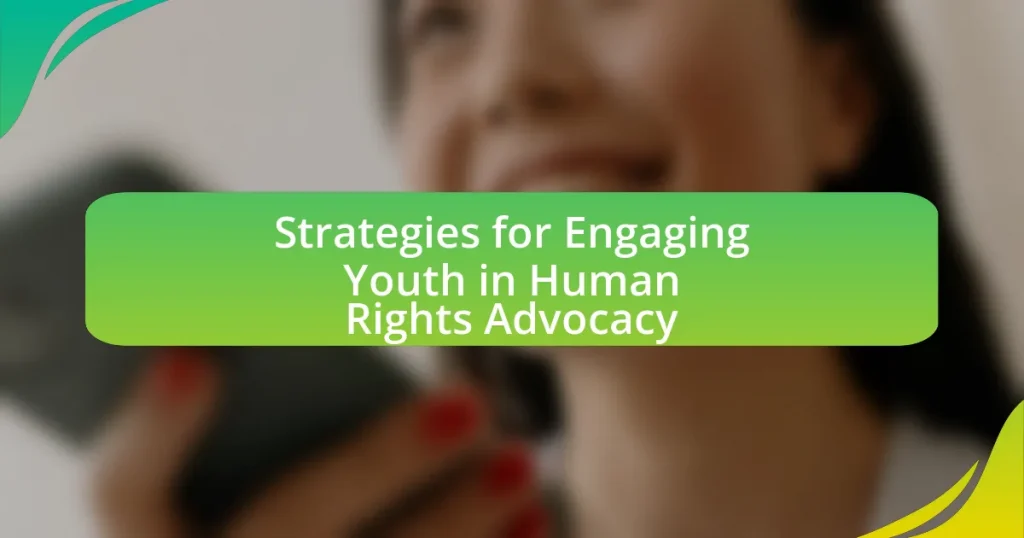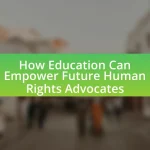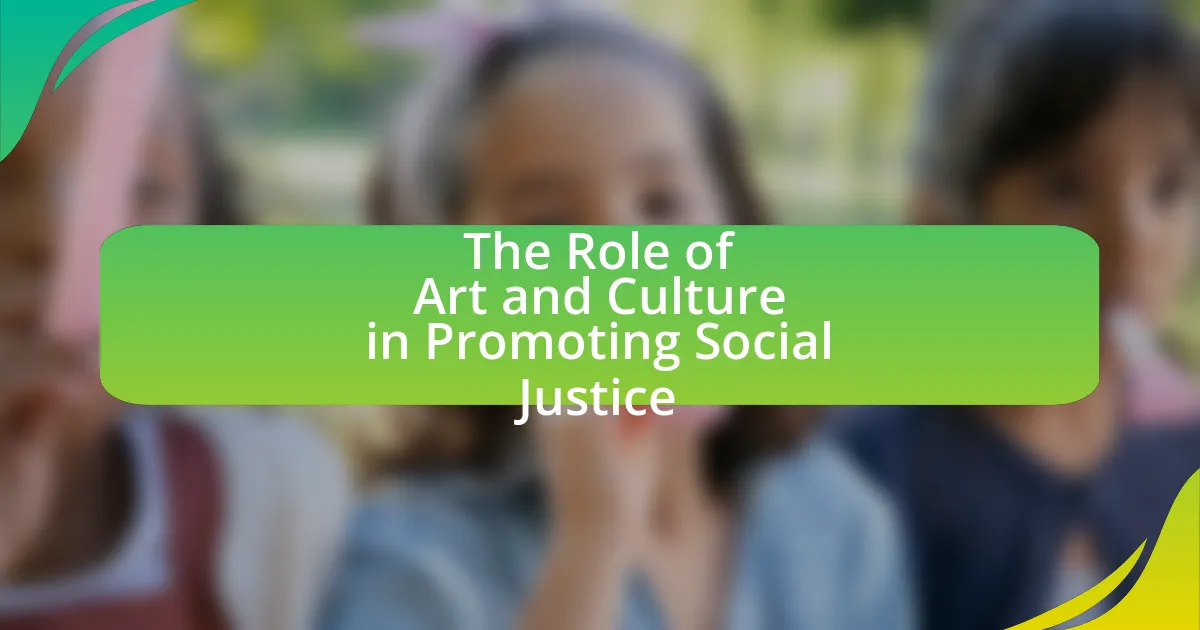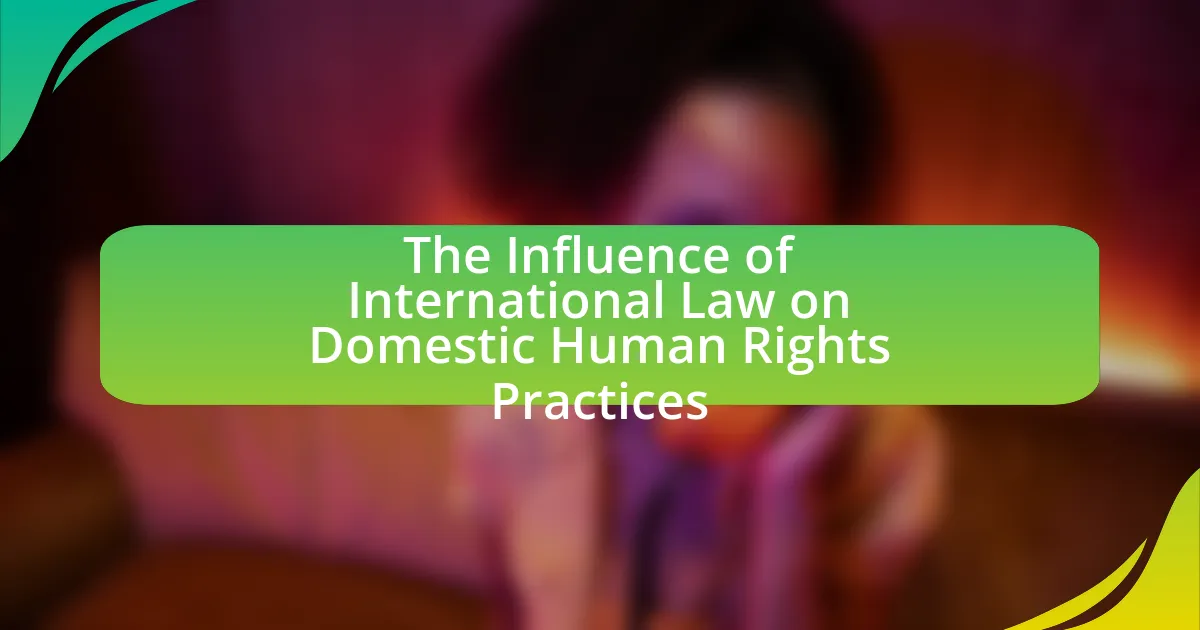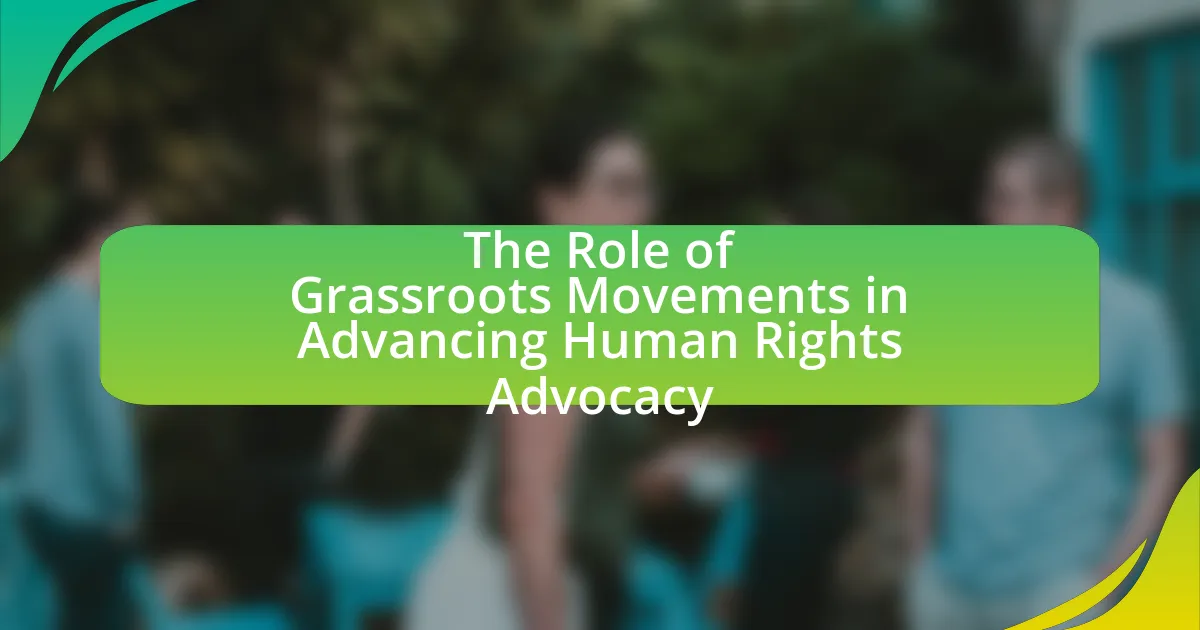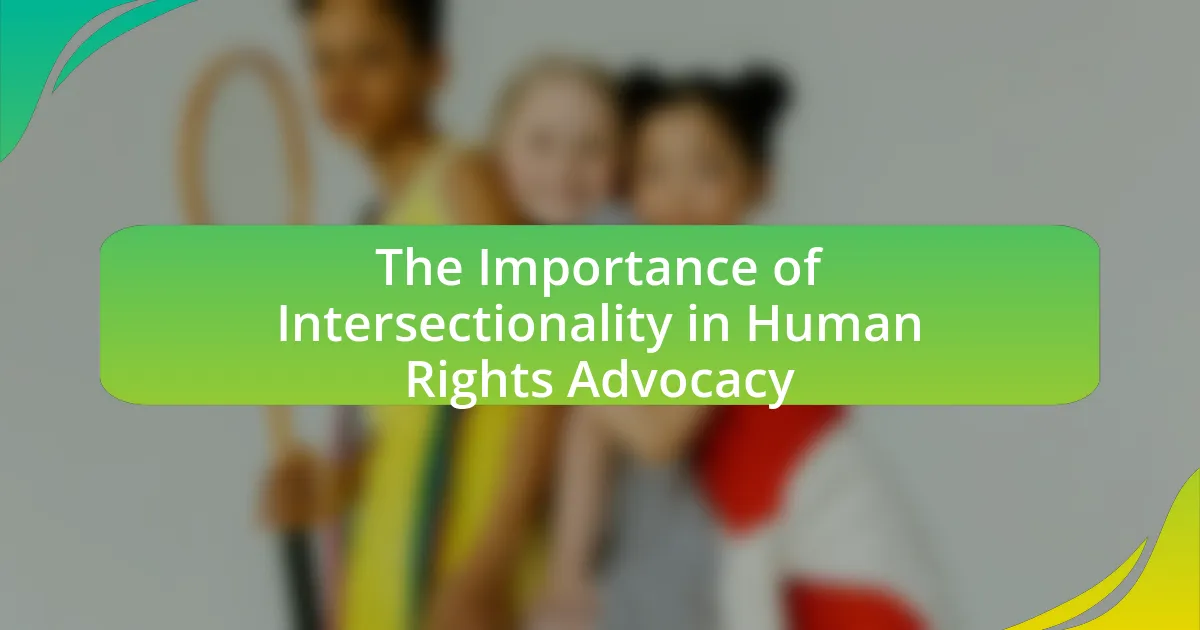The article focuses on strategies for engaging youth in human rights advocacy, emphasizing the importance of social media, peer-to-peer education, and participatory opportunities. It outlines how education plays a critical role in enhancing youth engagement by providing knowledge about human rights and advocacy mechanisms. The article also discusses effective educational programs, the role of social media in mobilizing youth, and the significance of peer engagement in fostering a culture of advocacy. Additionally, it addresses the challenges youth face in advocacy, including systemic barriers and personal obstacles, while highlighting the essential support systems and resources organizations can provide to empower young advocates.

What are the key strategies for engaging youth in human rights advocacy?
Key strategies for engaging youth in human rights advocacy include leveraging social media platforms, fostering peer-to-peer education, and creating participatory opportunities for involvement. Social media platforms, such as Instagram and TikTok, allow youth to share their perspectives and mobilize support quickly, as evidenced by movements like #BlackLivesMatter, which gained traction among younger demographics. Peer-to-peer education empowers youth to learn from each other, enhancing their understanding of human rights issues, as shown in programs like Amnesty International’s youth-led workshops. Additionally, providing participatory opportunities, such as internships or volunteer programs, encourages active involvement, which has been linked to increased commitment to advocacy efforts, as demonstrated by the success of youth-led organizations in various regions.
How can education play a role in youth engagement for human rights?
Education can significantly enhance youth engagement in human rights by equipping young individuals with knowledge about their rights and the mechanisms for advocating them. Through curricula that include human rights education, students learn about historical injustices, current human rights issues, and the importance of civic participation. For instance, studies show that programs integrating human rights education lead to increased awareness and activism among youth, as evidenced by the 2018 report from the United Nations Educational, Scientific and Cultural Organization (UNESCO), which highlights that students exposed to human rights concepts are more likely to participate in advocacy and community service. This foundational knowledge empowers youth to challenge injustices and promotes a culture of respect and advocacy for human rights within their communities.
What educational programs are most effective in promoting human rights awareness?
Educational programs that are most effective in promoting human rights awareness include experiential learning initiatives, such as workshops and simulations, as well as integrated curricula that incorporate human rights education across subjects. Research by the United Nations Educational, Scientific and Cultural Organization (UNESCO) indicates that programs emphasizing active participation, critical thinking, and real-world applications significantly enhance understanding and commitment to human rights principles. For instance, the “Teaching Respect for All” program developed by UNESCO has shown measurable improvements in students’ knowledge and attitudes towards human rights.
How can schools incorporate human rights topics into their curriculum?
Schools can incorporate human rights topics into their curriculum by integrating them across various subjects and promoting active learning through discussions, projects, and community engagement. For instance, history classes can explore significant human rights movements, while literature courses can analyze works that address social justice themes. Additionally, schools can implement service-learning projects that connect students with local human rights organizations, fostering real-world application of their knowledge. Research indicates that such interdisciplinary approaches not only enhance students’ understanding of human rights but also encourage critical thinking and civic engagement, as evidenced by programs like the United Nations’ “Teaching Human Rights” initiative, which provides resources for educators to effectively teach these topics.
What role does social media play in engaging youth in human rights advocacy?
Social media serves as a crucial platform for engaging youth in human rights advocacy by facilitating communication, mobilization, and awareness. It allows young individuals to share information rapidly, connect with like-minded peers, and participate in campaigns that promote human rights issues. For instance, the #BlackLivesMatter movement gained significant traction through social media, mobilizing millions of young activists globally and raising awareness about racial injustice. Research indicates that 71% of young people believe social media is an effective tool for advocating social change, highlighting its impact on youth engagement in human rights advocacy.
How can social media campaigns effectively raise awareness among young people?
Social media campaigns can effectively raise awareness among young people by utilizing targeted messaging and engaging content that resonates with their values and interests. Research indicates that 90% of young adults use social media, making it a powerful platform for outreach. Campaigns that incorporate interactive elements, such as polls, challenges, and user-generated content, foster participation and create a sense of community. Additionally, leveraging influencers who align with the campaign’s message can amplify reach and credibility, as studies show that 70% of teens trust influencers more than traditional celebrities. By focusing on relatable narratives and visual storytelling, social media campaigns can capture attention and drive meaningful engagement among youth.
What are the best practices for using social media to mobilize youth for human rights?
The best practices for using social media to mobilize youth for human rights include creating engaging content, utilizing influencers, fostering community, and leveraging data analytics. Engaging content, such as videos, infographics, and interactive posts, captures the attention of youth and encourages sharing, which amplifies the message. Influencers with a strong following can effectively reach and inspire young audiences, as seen in campaigns like #BlackLivesMatter, where social media influencers played a crucial role in spreading awareness. Building a sense of community through online groups and forums allows youth to connect, share experiences, and collaborate on initiatives, enhancing their commitment to human rights causes. Finally, leveraging data analytics helps organizations understand youth engagement patterns, allowing for tailored strategies that resonate with their interests and values.
Why is peer-to-peer engagement important in human rights advocacy?
Peer-to-peer engagement is crucial in human rights advocacy because it fosters authentic connections and empowers individuals to share their experiences and perspectives. This form of engagement allows advocates to mobilize grassroots support, as individuals are more likely to resonate with messages delivered by their peers rather than traditional authority figures. Research indicates that peer influence significantly impacts attitudes and behaviors, particularly among youth, making it an effective strategy for raising awareness and driving action in human rights issues. For instance, a study by the United Nations Development Programme highlights that youth-led initiatives utilizing peer engagement have successfully increased participation in human rights campaigns, demonstrating the effectiveness of this approach in creating a more informed and active community.
How can youth-led initiatives foster a culture of advocacy?
Youth-led initiatives can foster a culture of advocacy by empowering young people to take leadership roles in social issues, thereby increasing their engagement and influence. These initiatives provide platforms for youth to express their views, mobilize peers, and advocate for change, which cultivates a sense of ownership and responsibility towards societal challenges. For instance, programs like the Youth Advocacy Network have demonstrated that when young individuals are given the tools and resources to lead campaigns, they can effectively raise awareness and drive policy changes, as seen in various successful youth-led movements globally. This active participation not only enhances their skills but also inspires a collective commitment to advocacy within their communities.
What are some successful examples of peer-to-peer advocacy programs?
Successful examples of peer-to-peer advocacy programs include the “Youth Empowerment Program” by the United Nations, which trains young leaders to advocate for human rights in their communities. Another example is the “Peer Health Exchange,” which empowers college students to teach health education to high school students, fostering advocacy for health rights. Additionally, the “Youth for Human Rights International” program engages youth in promoting human rights education through peer-led initiatives. These programs demonstrate effectiveness by increasing awareness and engagement among young people in advocacy efforts.
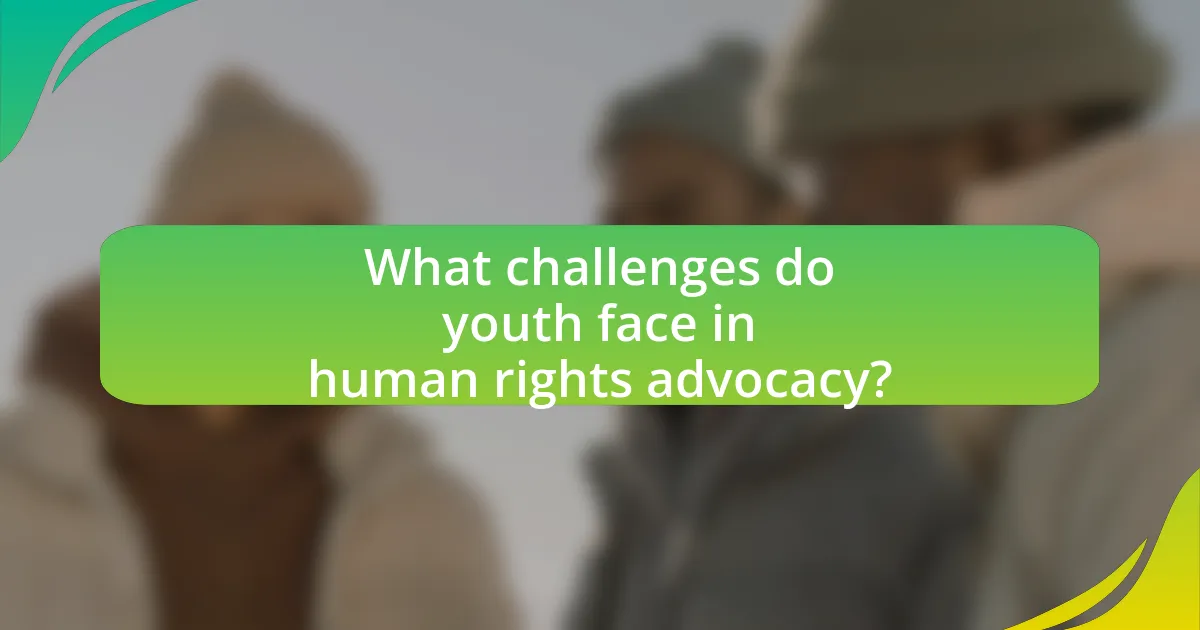
What challenges do youth face in human rights advocacy?
Youth face significant challenges in human rights advocacy, including lack of access to resources, limited political influence, and societal pushback. These obstacles hinder their ability to effectively promote and protect human rights. For instance, many young advocates struggle to secure funding or support for their initiatives, which can stifle their efforts. Additionally, youth often lack representation in decision-making processes, making it difficult for their voices to be heard. Furthermore, they may encounter resistance from established institutions or societal norms that oppose their advocacy efforts, leading to potential backlash or marginalization. These challenges collectively impede the capacity of youth to drive meaningful change in the realm of human rights.
How can systemic barriers hinder youth participation in advocacy?
Systemic barriers can significantly hinder youth participation in advocacy by creating obstacles that limit access to resources, information, and decision-making processes. These barriers include socioeconomic disparities, lack of representation in leadership roles, and institutional policies that do not accommodate youth voices. For instance, a study by the United Nations Development Programme highlights that youth from marginalized communities often face challenges such as inadequate education and financial constraints, which restrict their ability to engage in advocacy efforts effectively. Additionally, systemic discrimination can lead to a lack of trust in institutions, further discouraging youth from participating in advocacy initiatives.
What are the common obstacles faced by young advocates in their communities?
Young advocates in their communities commonly face obstacles such as lack of resources, limited access to decision-makers, and societal resistance. These challenges hinder their ability to effectively promote human rights and implement advocacy strategies. For instance, a study by the United Nations Development Programme highlights that youth often lack funding and mentorship opportunities, which are crucial for developing their advocacy skills. Additionally, young advocates frequently encounter barriers in engaging with local government officials, as they may not be taken seriously due to their age. Societal resistance can manifest in the form of discrimination or skepticism towards youth-led initiatives, further complicating their efforts to drive change.
How can organizations support youth in overcoming these barriers?
Organizations can support youth in overcoming barriers by providing access to resources, mentorship, and training programs that enhance their skills and confidence. For instance, organizations can offer workshops on advocacy, public speaking, and leadership, which empower youth to effectively engage in human rights issues. Research indicates that youth who participate in structured programs are more likely to develop critical thinking and advocacy skills, as shown in a study by the International Youth Foundation, which found that 75% of participants reported increased confidence in their ability to influence change. Additionally, creating safe spaces for dialogue and collaboration allows youth to share their experiences and challenges, fostering a supportive community that encourages active participation in human rights advocacy.
What personal challenges do young advocates encounter?
Young advocates encounter several personal challenges, including a lack of experience, emotional stress, and balancing advocacy with personal responsibilities. The inexperience can lead to feelings of inadequacy when navigating complex social issues, which may hinder their effectiveness. Emotional stress arises from confronting difficult realities and the pressure to create change, often resulting in burnout. Additionally, young advocates frequently struggle to balance their advocacy work with academic or job commitments, which can limit their availability and focus. These challenges are documented in studies highlighting the mental health impacts of activism on youth, emphasizing the need for support systems to help them navigate these obstacles effectively.
How can young people build resilience in the face of adversity?
Young people can build resilience in the face of adversity by developing strong social connections, practicing self-care, and cultivating a growth mindset. Strong social connections provide emotional support and a sense of belonging, which are crucial during challenging times. Research indicates that individuals with supportive relationships are better equipped to cope with stress and adversity. Practicing self-care, such as maintaining physical health through exercise and proper nutrition, enhances overall well-being and equips young people to handle difficulties more effectively. Additionally, cultivating a growth mindset—believing that abilities can be developed through dedication and hard work—encourages young people to view challenges as opportunities for growth rather than insurmountable obstacles. This mindset has been shown to improve resilience and adaptability in various studies, including those conducted by psychologists like Carol Dweck.
What support systems are essential for youth advocates?
Essential support systems for youth advocates include mentorship programs, access to resources, and community networks. Mentorship programs provide guidance and knowledge from experienced advocates, which is crucial for skill development and confidence building. Access to resources, such as training materials and funding opportunities, enables youth advocates to effectively engage in their initiatives. Community networks foster collaboration and support among peers, enhancing the impact of advocacy efforts. These systems collectively empower youth advocates to navigate challenges and amplify their voices in human rights advocacy.
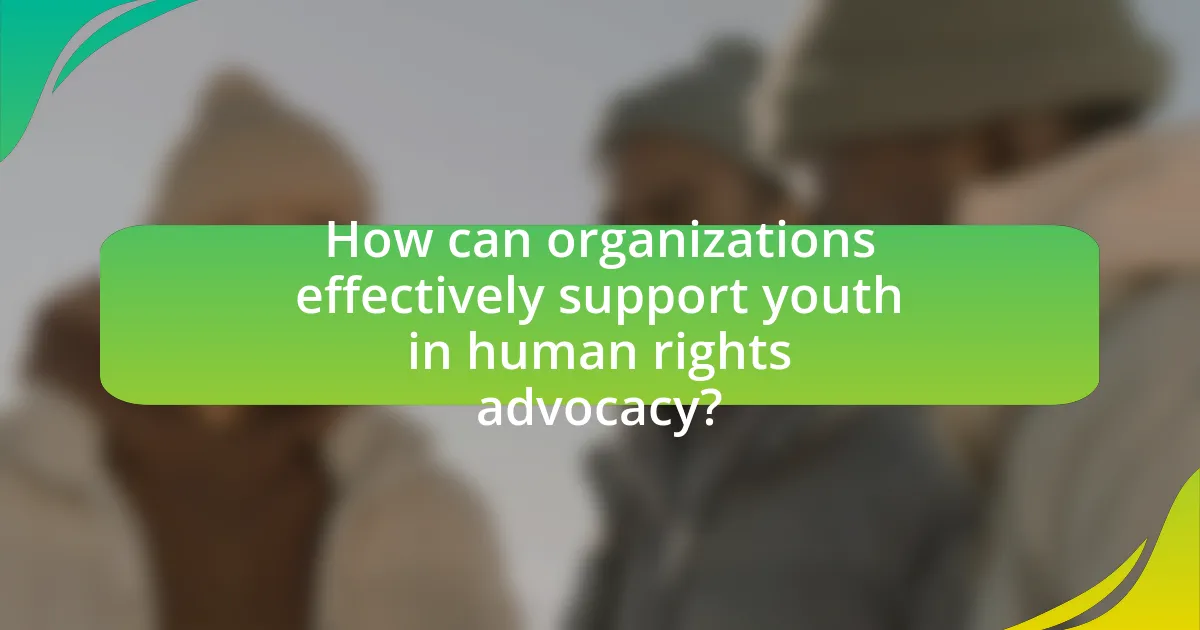
How can organizations effectively support youth in human rights advocacy?
Organizations can effectively support youth in human rights advocacy by providing education, resources, and platforms for engagement. By offering training programs on human rights issues, organizations equip young advocates with the knowledge and skills necessary to engage in meaningful dialogue and action. For instance, initiatives like the United Nations Youth Delegate Program have successfully empowered youth by involving them in global discussions, demonstrating that structured involvement leads to increased advocacy effectiveness. Additionally, organizations can create mentorship opportunities that connect experienced advocates with youth, fostering a supportive environment that encourages leadership development. Research indicates that youth-led initiatives, when supported by established organizations, can lead to significant social change, as seen in movements like the global climate strikes initiated by young activists.
What resources are essential for empowering youth advocates?
Essential resources for empowering youth advocates include training programs, mentorship opportunities, access to information, and funding support. Training programs equip youth with skills in advocacy, public speaking, and leadership, which are crucial for effective engagement. Mentorship opportunities connect young advocates with experienced professionals who can provide guidance and support, enhancing their confidence and capabilities. Access to information, such as research, case studies, and best practices, enables youth to understand the issues they are advocating for and to develop informed strategies. Funding support is vital for enabling youth-led initiatives and projects, allowing them to implement their advocacy efforts effectively. These resources collectively foster a supportive environment that enhances the impact of youth advocates in human rights advocacy.
How can funding and grants be utilized to support youth-led initiatives?
Funding and grants can be utilized to support youth-led initiatives by providing essential financial resources that enable young leaders to implement their projects effectively. These funds can cover costs such as program development, outreach activities, training sessions, and necessary materials, which are crucial for the success of initiatives aimed at promoting human rights. For instance, organizations like the United Nations Development Programme have allocated grants specifically for youth-led projects, demonstrating a commitment to empowering young advocates. Additionally, research indicates that youth-led initiatives funded through grants often lead to increased community engagement and awareness of human rights issues, as evidenced by the success of programs funded by the European Union’s Youth in Action program, which has supported numerous youth-led projects across Europe.
What training opportunities should organizations provide for young advocates?
Organizations should provide training opportunities in advocacy skills, public speaking, and policy analysis for young advocates. These training programs equip youth with essential tools to effectively communicate their messages, understand legislative processes, and engage with stakeholders. For instance, workshops on public speaking can enhance their ability to present ideas confidently, while policy analysis training helps them critically evaluate and influence policies relevant to human rights. Research indicates that youth trained in these areas are more likely to participate actively in advocacy efforts, as evidenced by a study from the International Youth Foundation, which found that 75% of trained youth reported increased engagement in civic activities.
How can partnerships enhance youth engagement in human rights advocacy?
Partnerships can enhance youth engagement in human rights advocacy by providing resources, mentorship, and platforms for collaboration. When organizations partner with youth-led groups, they can leverage their networks and expertise to create more impactful advocacy campaigns. For instance, partnerships can facilitate training programs that equip young advocates with essential skills, such as public speaking and policy analysis, thereby increasing their effectiveness. Additionally, collaborative initiatives can amplify youth voices in decision-making processes, as seen in the United Nations’ Youth Delegate Program, which empowers young people to participate in global discussions on human rights. This approach not only fosters a sense of ownership among youth but also ensures that their perspectives are represented in advocacy efforts.
What types of partnerships are most beneficial for youth advocacy efforts?
Collaborative partnerships between youth organizations, educational institutions, and governmental agencies are most beneficial for youth advocacy efforts. These partnerships leverage resources, expertise, and networks to amplify youth voices and enhance advocacy initiatives. For instance, collaborations with educational institutions can provide youth with critical skills and knowledge, while partnerships with governmental agencies can facilitate access to policy-making processes. Research indicates that such multi-sector collaborations lead to more effective advocacy outcomes, as they combine diverse perspectives and resources, ultimately fostering a more inclusive approach to human rights advocacy.
How can collaboration between organizations and youth lead to impactful change?
Collaboration between organizations and youth can lead to impactful change by leveraging the innovative ideas and energy of young people alongside the resources and experience of established entities. This partnership fosters a two-way exchange of knowledge, where organizations gain fresh perspectives on pressing issues, while youth acquire valuable skills and insights into advocacy processes. For instance, initiatives like the United Nations’ Youth 2030 Strategy emphasize the importance of youth engagement in decision-making, demonstrating that when young people are actively involved, they can drive significant social change, as evidenced by youth-led movements that have successfully influenced policies on climate change and social justice.
What are some practical tips for engaging youth in human rights advocacy?
To engage youth in human rights advocacy, organizations should implement interactive and relatable educational programs. These programs can include workshops, social media campaigns, and community service projects that resonate with young people’s interests and values. For instance, a study by the United Nations Educational, Scientific and Cultural Organization (UNESCO) highlights that youth are more likely to participate in advocacy when they feel a personal connection to the issues being addressed. Additionally, providing platforms for youth to voice their opinions and experiences fosters a sense of ownership and empowerment, which is crucial for sustained engagement in human rights initiatives.
How can organizations create inclusive spaces for youth participation?
Organizations can create inclusive spaces for youth participation by actively involving diverse youth voices in decision-making processes. This can be achieved through structured programs that prioritize representation from various backgrounds, ensuring that marginalized groups are included. Research indicates that inclusive practices, such as youth-led initiatives and collaborative workshops, enhance engagement and foster a sense of belonging among participants. For example, the “Youth Participation in Decision-Making” report by the United Nations highlights that organizations that implement inclusive strategies see increased youth involvement and empowerment, leading to more effective advocacy outcomes.
What strategies can be employed to maintain youth interest and involvement in advocacy efforts?
To maintain youth interest and involvement in advocacy efforts, organizations should implement interactive and technology-driven engagement strategies. These strategies include utilizing social media platforms to create dynamic campaigns that resonate with youth values, such as social justice and environmental sustainability. Research indicates that 90% of young people use social media, making it an effective tool for outreach and mobilization (Pew Research Center, 2021). Additionally, providing opportunities for hands-on involvement, such as volunteering, internships, and leadership roles, fosters a sense of ownership and commitment among youth. Programs that incorporate peer-to-peer mentorship have been shown to enhance engagement, as they create relatable connections and encourage active participation.
